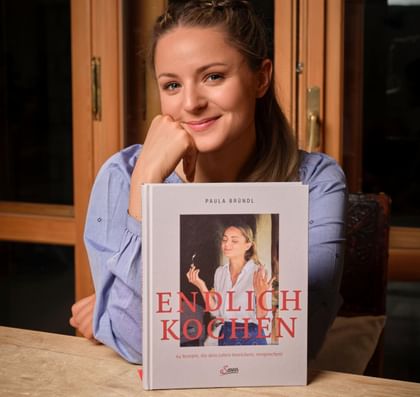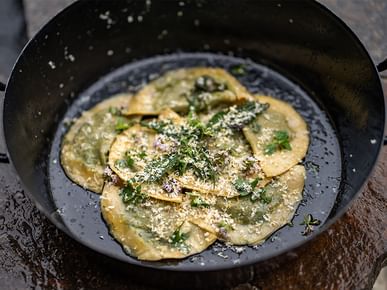Cooking at last!
A culinary moving cookbook
Paula Bründl, daughter of Christoph Bründl, has followed her very own path. The Pinzgau native with South Tyrolean roots is a trained psychologist, enthusiastic outdoor adventurer, and passionate hunter. But she has made a name for herself through a very special passion: cooking. In her new book Finally Cooking, Paula shows us in a refreshing way how enriching culinary experiences can be—a journey full of discoveries. Each recipe in Paula’s book tells a personal story. For you, she has selected five special chapters and answered our curious questions.
Categories:
People
Down to Earth
The Discovery of Gratitude & Mindfulness
“My path into the kitchen began in the Ahrntal Valley in South Tyrol, where I spent every free moment as a child on my grandparents’ farm. Whether with newborn calves or drinking fresh milk – I was the happiest child in the world. Back then, it was the farm’s adventures that drew me in; today, it’s the deep connection to the origins of things that fascinates me. I saw how grass became juicy feed, feed turned into milk – the white gold of our homeland. Those who work with nature receive its gifts. For me, it’s only natural to use these gifts in their entirety. Anyone who has ever milked a cow, butchered a lamb, or tended a vegetable garden will never waste nature. That’s why, for me, understanding where things come from, knowing our roots, and respecting agricultural work are essential.”
Bründl Sports: How do you approach the topic of "Zero Waste" in the kitchen?
Paula: What used to be second nature is now often labeled as “zero waste” cooking in our fast-paced and wasteful world. But at its core – like so many things in life – it’s really about appreciation, gratitude, and humility towards the gifts of nature. My Pumperlgsund juice is a perfect example: even wilted vegetables or wrinkled fruit can be given new purpose – in the form of a truly nourishing, healthy smoothie.
Recipe: Pumperlgsund-Smoothie
"Every now and then, it’s time to say: everything must go! Out of the veggie drawer, the fruit basket, and the pantry. From tired vegetables, overripe fruit, nuts, and seeds, I blend a truly powerful Pumperlgsund juice. It gives us so much energy, vitamins, and nutrients in the morning that we feel twice as productive at work. Plus, it gives even the saddest spinach, a browned apple, or a shriveled celery one last meaningful purpose."
-
3 parts assorted vegetables (carrots, spinach, celery, broccoli, kale...)
-
1 part fruits (apple, berries, pears, cherries...)
-
4 tbsp seeds (hemp seeds, flaxseeds, psyllium seeds...)
-
Juice of 1 lemon
-
1 tbsp turmeric
-
A bit of water
Blend all ingredients on high speed with a little water. Add more water as needed to reach your preferred consistency. The juice keeps for up to 3 days in the fridge.

Refueling Energy
The Most Elegant Medicine in the World
“Health and energy had always come naturally to me – until a student exchange in the U.S. showed me the opposite. Suddenly, my diet consisted of ready-made meals and microwave dishes instead of the freshly cooked food I knew from my mother. At first, it was exciting – but it quickly drained my energy. During swim training, I lacked strength and felt sluggish and unwell. That experience opened my eyes to how much nutrition affects our body and well-being. I started listening to my body, tried many things – sometimes too extreme. A phase of overly restrictive eating taught me that deprivation alone doesn’t make you healthy. My biggest insight came through the Colombian tranquilidad – a relaxed, intuitive approach to food. Enjoyment and health don’t have to be opposites. In this chapter, I share my favorite sources of strength – foods that not only nourish but truly delight.”
Bründl Sports: Do you have personal rituals or favorite dishes that give you energy?
Paula: I love the world of herbs – especially when combining several at once. My favorite is a herb sauce made from whatever’s in season, blended with a generous splash of buttermilk, a bit of vinegar, and sour cream. This refreshing, light sauce pairs perfectly with gently cooked trout or char. And just like that, you’ve got a fresh, light, and nourishing dish that gives you the energy to power through the day.
Recipe: Fresh Trout with Garden Greens
This light, delicate fish dish is perfect for days when you don’t want to weigh yourself down with heavy food. It’s quick and very easy to prepare. The herb buttermilk sauce is a delightful, summery addition that brings freshness and lightness to any dish.
Serves approx. 4
For the fish:
-
400 g trout fillets
-
A little olive oil
-
A pinch of salt
-
Juice of 1 lemon
For the cucumber salad:
-
1 large cucumber
-
Salt, vinegar, olive oil
For the buttermilk sauce:
-
A splash of white balsamic condimento
-
50 g lamb’s lettuce
-
50 g mixed herbs (parsley, chives, mint, lovage)
-
125 ml sour cream
-
100 ml buttermilk
-
50 g crème fraîche
-
1 tsp horseradish
-
Salt, pepper
Also: A few salad leaves, herbs and mint, olive oil, freshly grated horseradish
Preheat the oven to 80°C fan. Place the trout fillets on a sheet of baking paper brushed with olive oil and generously brush the tops with olive oil as well. For the salad garnish, peel the cucumber, slice it finely, and salt it immediately. Clean and roughly chop the salad leaves, then dress with vinegar, salt, and olive oil. Marinate the cucumber the same way. For the sauce, blend all the ingredients in a high-speed blender until smooth and creamy. Gently warm the trout fillets in the oven for about 10–15 minutes, depending on their thickness (tip: press gently with your finger – if they yield slightly, they’re done). Once cooked, remove from the oven, season with salt, and drizzle with lemon juice. To serve, place the cucumber salad with a bit of sauce in deep plates, top with the trout fillets, and garnish with fresh herbs, salad leaves, mint, and a drizzle of olive oil. Finish with freshly grated horseradish.
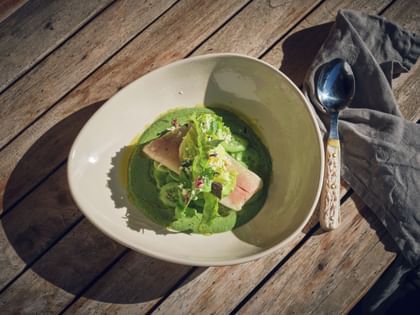
Letting Go
The Meditative Power of Kneading Dough
"There is a special power in working with your hands – it connects us to our most original human nature. What could be more meaningful than creating food with your own hands? Cooking gives us a deep sense of fulfillment because it engages us with the truly important things in life. When everyday life catches up with me, I find peace in the kitchen. Especially when kneading dough, this meditative power unfolds: I am fully present, and the mental chatter fades away. The reward? Filled pasta, fresh bread, or sweet pastries. Because as much as the journey may be the destination – in cooking, the destination tastes irresistibly good."
Bründl Sports: Are there any rituals or traditions around cooking and eating in your family?
Paula: There were quite a few – one of them was our evening Jause when Mom’s kitchen stayed cold. A table full of delicious treats from the pantry and the best products from local farmers. As quick and simple as it was to prepare, it was just as enjoyable to eat. The foundation of any Jause, of course, is a really good loaf of bread. And I’ve found my very own favorite recipe for that.
Recipe: My Beloved Spelt & Walnut Loaf
"My first attempts at baking a good loaf of bread go back to the quiet, cozy time of the COVID lockdowns. The taste of freshly baked bread—still slightly warm, wonderfully crisp, and filling the house with its aroma—is simply unmatched. That’s why I still bake my own bread whenever I have time. To make it last and avoid wasting any of the good loaf, I slice and freeze part of the fresh bread right away. Two minutes in the toaster, and it tastes like it just came out of the oven—ready for butter, honey, and more. To keep it simple, I use fresh yeast, but only a tiny amount, allowing it to rise slowly. This makes the bread easier to digest, more flavorful, and lighter. For flour, I always use a mix of old grain varieties and regional specialties: einkorn, kamut, red wheat, spelt, or rye. One thing never changes: the joy of baking it myself."
For 2 loaves of approx. 900 g each
For the pre-dough (Dampfl):
-
6 g fresh yeast
-
1 tsp honey
-
100 ml warm water
For the main dough:
-
160 g walnut halves
-
600 ml water (room temperature)
-
300 g white wheat bread flour
-
300 g whole spelt flour (or whole emmer, kamut, rye flour)
-
400 g white spelt flour
-
15 g salt
-
10 g malt powder
-
10 g bread spice
-
3 tbsp olive oil
Roast the walnuts in the oven at 160°C for 8–10 minutes until lightly browned. Let cool and coarsely chop. For the pre-dough, dissolve the yeast and honey in warm water (30°C) and let it rest at room temperature for 30 minutes. At the same time, combine the three flours and water for the main dough in a mixing bowl and let it rest for 30 minutes as well. This process is called autolysis and allows the flour to absorb water before yeast and salt are added. After 30 minutes, add the pre-dough to the flour mixture and knead slowly for 3 minutes. Then add salt, malt powder, and bread spice, and knead for another 10 minutes. Finally, mix in the walnuts and 2 tablespoons of olive oil, and knead for 2 more minutes. The dough should be smooth, elastic, and easy to remove from the bowl—don’t worry if it’s still quite moist. Grease a bowl with olive oil, place the dough in it, and lightly oil the surface of the dough. Now fold the dough three times: with both hands, lift the dough from both sides, stretch it gently, and fold the front and back down into the bowl. Turn the bowl 180° and repeat. Do this two more times. Cover the bowl and let the dough rest for 30 minutes at room temperature. Repeat the folding process with four turns, then rest another 30 minutes. Fold one last time with four turns. The dough should now feel firmer and more compact. If not, fold once more. Next, shape the dough. If you want two smaller loaves, divide it; if not, leave it whole. Place the dough on a floured surface, and fold the edges from the outside in to create surface tension. A seam will form on top. Place the dough seam-side up in a floured proofing basket, cover with a kitchen towel, and refrigerate overnight. Preheat the oven (and baking tray) to 220°C. Take the dough straight from the fridge, place it seam-side down on a piece of parchment paper, and score the top with a long, light cut. Slide the paper and loaf onto the hot tray and bake on the lowest rack. After 20 minutes, reduce the temperature to 190°C and bake for another 35 minutes. Let the bread cool for at least 2 hours before slicing.
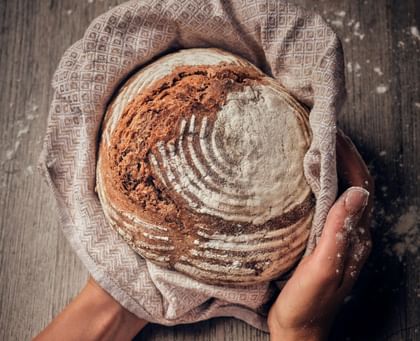
Coming Forth
Nature’s Treasures
“As a cook, the ultimate feeling of freedom for me is sourcing my own food from nature – from wild herbs and mushrooms to berries and game meat. Walking slowly through forests and meadows with an attentive eye is soothing and calming. Every mushroom I find feels like a little triumph and adds special value to dishes like chanterelle goulash. A few years ago, I began diving deeper into learning about the animals that inhabit our forests. I wanted to understand how I could behave respectfully as a mountain sports enthusiast, and how to harvest animals in a meaningful way that honors their meat. Since then, I’ve seen nature through new eyes. Taking the life of an animal is always a moving experience – it makes me deeply aware of the effort and sacrifice behind meat as food, and it strengthens my sense of gratitude.”
Bründl Sports: Which local and often underestimated “superfoods” can be easily integrated into everyday cooking to support health?
Paula: My favorite local super-herbs are wormwood, sorrel, oregano, and good old nettles. Incredibly flavorful and good for the body. And let’s not forget Moosbeeren (bilberries or wild blueberries) – packed with power and so versatile, whether as juice, jam, or little dumplings.
Salzburg’s Sweet Cure: Wild Blueberry Dumplings & Lingonberry Buttermilk
"The miraculous healing powers of wild-growing bilberries—known in the Pinzgau region as Moosbeeren—are legendary. They’re said to boost brain function, support liver health, and strengthen the nerves. These deep blue, almost black berries are considered the most powerful prebiotic in the plant kingdom and are packed with antioxidants that have pain-relieving and antibacterial properties. So it’s no exaggeration to call these wonder-berries true medicine. In this spirit, the sweet and tangy Moosbeernocken are, of course, prepared and enjoyed strictly for therapeutic purposes."
For the Moosbeernocken (Wild Bilberry Dumplings)
-
500 g wild bilberries (Moosbeeren)
-
approx. 100 g coarse wheat or spelt flour
-
4 tbsp milk
-
1 pinch of salt
-
2 tbsp brown sugar
Also: clarified butter, regular butter, brown sugar, powdered sugar for dusting
For the lingonberry buttermilk:
-
500 ml buttermilk
-
5 tbsp lingonberries
-
1 tbsp honey
Mix the bilberries with flour, milk, salt, and sugar until well combined. Heat about 2 tbsp clarified butter in a pan and spoon in small dumplings of the berry mixture. The pan should be hot but not too hot. After 3–5 minutes, sprinkle with brown sugar and flip the dumplings. Add 2 tbsp butter to the pan and continue frying for another 3–5 minutes. Sprinkle again with brown sugar. For the buttermilk, blend all ingredients briefly with an immersion blender. Serve the Moosbeernocken on a flat plate, dusted with powdered sugar. They pair beautifully with a scoop of vanilla ice cream, sweetened sour cream, or cinnamon cream.
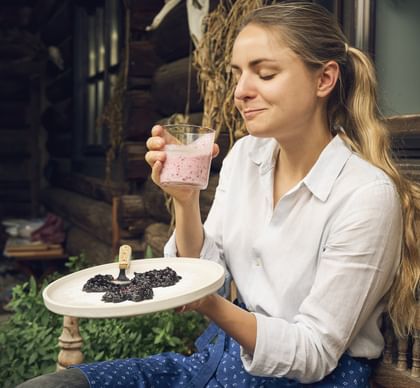
Moving Forward
Do I want to be perfect – or do I want to take action?
“During my chef training, I learned that challenges are a gift. As a career changer, I was initially met with skepticism – but those very hurdles helped me grow and push past my limits. My apprenticeship wasn’t just a school of cooking, but a school of life – because real magic only happens outside your comfort zone. Early on, I realized that mistakes aren’t enemies, but valuable teachers. A learning curve without mistakes isn’t a curve – it’s stagnation. Perfectionism can be paralyzing. I often found myself overthinking the perfect outcome – and sometimes not acting at all. But cooking taught me this: only those who experiment fearlessly can create something new. The key lies in a beginner’s mindset – staying open, curious, and bold. I love exploring new paths in the kitchen with joy and passion, cooking my own soup, and breaking boundaries. And that’s something anyone can do: be brave, try things out, and enjoy the moment when it works.”
Bründl Sports: What message would you like to share with our readers as they embark on their own culinary journey?
Paula: I really just want one thing – to move people through food: whether in videos, photos, at catering events or private cooking sessions. If you cook, you’re already on your way to a fulfilled life. Because life happens in the kitchen – complete with failure, success, and experimentation. And always with that extra dose of joy, love, and excitement.
